Electric-Field-Tunable Transport and Photo-Resistance Properties in LaMnO3−x/PMN-PT Heterostructures
Abstract
:1. Introduction
2. Materials and Methods
3. Results and Discussions
4. Conclusions
Author Contributions
Funding
Institutional Review Board Statement
Informed Consent Statement
Data Availability Statement
Conflicts of Interest
References
- Wu, S.M.; Cybart, S.A.; Yu, P.; Rossell, M.D.; Zhang, J.X.; Ramesh, R.; Dynes, R.C. Reversible electric control of exchange bias in a multiferroic field-effect device. Nat. Mater. 2010, 9, 756–761. [Google Scholar] [CrossRef] [PubMed]
- Hoffman, J.; Pan, X.; Reiner, J.W.; Walker, F.J.; Han, J.P.; Ahn, C.H.; Ma, T.P. Ferroelectric field effect transistors for memory applications. Adv. Mater. 2010, 22, 2957–2961. [Google Scholar] [CrossRef] [PubMed]
- Eerenstein, W.; Mathur, N.D.; Scott, J.F. Multiferroic and magnetoelectric materials. Nature 2006, 442, 759–765. [Google Scholar] [CrossRef] [PubMed]
- Ramesh, R.; Spaldin, N.A. Multiferroics: Progress and prospects in thin films. Nat. Mater. 2007, 6, 21–29. [Google Scholar] [CrossRef]
- Eerenstein, W.; Wiora, M.; Prieto, J.L.; Scott, J.F.; Mathur, N.D. Giant sharp and persistent converse magnetoelectric effects in multiferroic epitaxial heterostructures. Nat. Mater. 2007, 6, 348–351. [Google Scholar] [CrossRef] [Green Version]
- Zheng, M.; Usami, T.; Taniyama, T. Shear-strain-mediated large nonvolatile tuning of ferromagnetic resonance by an electric field in multiferroic heterostructures. NPG Asia Mater. 2021, 13, 7. [Google Scholar] [CrossRef]
- Hu, J.M.; Li, Z.; Chen, L.Q.; Nan, C.W. High-density magnetoresistive random access memory operating at ultralow voltage at room temperature. Nat. Commun. 2011, 2, 553. [Google Scholar] [CrossRef]
- Heron, J.T.; Bosse, J.L.; He, Q.; Gao, Y.; Trassin, M.; Ye, L.; Clarkson, J.D.; Wang, C.; Liu, J.; Salahuddin, S. Deterministic switching of ferromagnetism at room temperature using an electric field. Nature 2014, 516, 370–373. [Google Scholar] [CrossRef]
- Zhao, Y.Y.; Wang, J.; Kuang, H.; Hu, F.X.; Zhang, H.R.; Liu, Y.; Zhang, Y.; Wang, S.H.; Wu, R.R.; Zhang, M.; et al. Abnormal percolative transport and colossal electroresistance induced by anisotropic strain in (011)-Pr0.7(Ca0.6Sr0.4)0.3MnO3/PMN-PT heterostructure. Sci. Rep. 2014, 4, 7075. [Google Scholar] [CrossRef] [Green Version]
- Thiele, C.; Dörr, K.; Bilani, O.; Rödel, J.; Schultz, L. Influence of strain on the magnetization and magnetoelectric effect in La0.7A0.3MnO3/PMN-PT(001) (A = Sr, Ca). Phys. Rev. B 2007, 75, 054408. [Google Scholar] [CrossRef] [Green Version]
- Liu, M.; Hoffman, J.; Wang, J.; Zhang, J.; Nelson-Cheeseman, B.; Bhattacharya, A. Non-volatile ferroelastic switching of the Verwey transition and resistivity of epitaxial Fe3O4/PMN-PT (011). Sci. Rep. 2013, 3, 1876. [Google Scholar] [CrossRef] [Green Version]
- Zheng, M.; Ni, H.; Xu, X.; Qi, Y.; Li, X.; Gao, J. Optically Tunable Resistive-Switching Memory in Multiferroic Heterostructures. Phys. Rev. Appl. 2018, 9, 044039. [Google Scholar] [CrossRef] [Green Version]
- Ni, H.; Zheng, M.; Chen, L.; Huang, W.; Qi, Y.; Zeng, J.; Tang, Z.; Lu, H.; Gao, J. Large nonvolatile multiple-state resistive switching in TiO2-δ/PMN-PT field-effect device. Appl. Phys. Lett. 2017, 110, 213503. [Google Scholar] [CrossRef] [Green Version]
- Thiele, C.; Dörr, K.; Fähler, S.; Schultz, L.; Meyer, D.C.; Levin, A.A.; Paufler, P. Voltage-controlled epitaxial strain in La0.7Sr0.3MnO3/Pb(Mg1/3Nb2/3)O3-PbTiO3(001) films. Appl. Phys. Lett. 2005, 87, 262502. [Google Scholar] [CrossRef]
- Guo, E.J.; Gao, J.; Lu, H.B. Strain-mediated electric-field control of photoinduced demagnetization in La0.8Ca0.2MnO3 thin films. Appl. Phys. Lett. 2011, 98, 081903. [Google Scholar] [CrossRef] [Green Version]
- Zheng, M.; Guan, P.; Qi, Y.; Tang, Z.; Ni, H.; Gao, J. Tuning the Phase Separation, Charge Ordering, and Electronic Transport in Electron-Doped Manganite Films by Piezo-Strain and Magnetic Field. Adv. Electron. Mater. 2021, 7, 2100603. [Google Scholar] [CrossRef]
- Liu, X.; Zheng, M.; Yang, J.; Guan, P.; Zhang, F.; Wang, Y.; Ni, H. Electro−Photo Double Control of Resistive Switching in Electron-Doped La0.9Hf0.1MnO3 Films. Physica Status Solidi (RRL)–Rapid Res. Lett. 2022, 16, 2100474. [Google Scholar] [CrossRef]
- Yan, H.; Feng, Z.; Shang, S.; Wang, X.; Hu, Z.; Wang, J.; Zhu, Z.; Wang, H.; Chen, Z.; Hua, H.; et al. A piezoelectric, strain-controlled antiferromagnetic memory insensitive to magnetic fields. Nat. Nanotechnol. 2019, 14, 131–136. [Google Scholar] [CrossRef]
- Liu, Z.; Feng, Z.; Yan, H.; Wang, X.; Zhou, X.; Qin, P.; Guo, H.; Yu, R.; Jiang, C. Antiferromagnetic piezospintronics. Adv. Electron. Mater. 2019, 5, 1900176. [Google Scholar] [CrossRef] [Green Version]
- Guo, H.; Feng, Z.; Yan, H.; Liu, J.; Zhang, J.; Zhou, X.; Qin, P.; Cai, J.; Zeng, Z.; Zhang, X.; et al. Giant piezospintronic effect in a noncollinear antiferromagnetic metal. Adv. Mater. 2020, 32, 2002300. [Google Scholar] [CrossRef]
- Chen, Z.; Chen, Z.; Liu, Z.Q.; Holtz, M.E.; Li, C.J.; Wang, X.R.; Lü, W.M.; Motapothula, M.; Fan, L.S.; Turcaud, J.A.; et al. Electron accumulation and emergent magnetism in LaMnO3/SrTiO3 heterostructures. Phys. Rev. Lett. 2017, 119, 156801. [Google Scholar] [CrossRef] [PubMed] [Green Version]
- Xu, Z.T.; Jin, K.J.; Gu, L.; Jin, Y.L.; Ge, C.; Wang, C.; Guo, H.Z.; Lu, H.b.; Zhao, R.Q.; Yang, G.Z. Evidence for a crucial role played by oxygen vacancies in LaMnO3 resistive switching memories. Small 2012, 8, 1279–1284. [Google Scholar] [CrossRef] [PubMed]
- Zhao, R.; Jin, K.; Xu, Z.; Guo, H.; Wang, L.; Ge, C.; Lu, H.; Yang, G. The oxygen vacancy effect on the magnetic property of the LaMnO3-δ thin films. Appl. Phys. Lett. 2013, 102, 122402. [Google Scholar] [CrossRef] [Green Version]
- Zhang, S.; Zhao, Y.G.; Li, P.S.; Yang, J.J.; Rizwan, S.; Zhang, J.X.; Seidel, J.; Qu, T.L.; Yang, Y.J.; Luo, Z.L.; et al. Electric-field control of nonvolatile magnetization in Co40Fe40B20/Pb(Mg1/3Nb2/3)0.7Ti0.3O3 structure at room temperature. Phys. Rev. Lett. 2012, 108, 137203. [Google Scholar] [CrossRef]
- Wu, T.; Bur, A.; Zhao, P.; Mohanchandra, K.P.; Wong, K.; Wang, K.L.; Lynch, C.S.; Carman, G.P. Giant electric-field-induced reversible and permanent magnetization reorientation on magnetoelectric Ni/(011)[Pb(Mg1/3Nb2/3)O3](1-x)-[PbTiO3]x heterostructure. Appl. Phys. Lett. 2011, 98, 012504. [Google Scholar] [CrossRef] [Green Version]
- Kanki, T.; Park, Y.G.; Tanaka, H.; Kawai, T. Electrical-field control of metal–insulator transition at room temperature in Pb(Zr0.2Ti0.8)O3/La1-xBaxMnO3 field-effect transistor. Appl. Phys. Lett. 2003, 83, 4860–4862. [Google Scholar] [CrossRef]
- Wu, L.; Zhang, C.; Dong, C.; Jia, C.; Jiang, C.; Xue, D. Polarization-induced resistive switching behaviors in complex oxide heterostructures. Appl. Phys. Lett. 2015, 107, 122905. [Google Scholar] [CrossRef]
- Tobe, K.; Kimura, T.; Okimoto, Y.; Tokura, Y. Anisotropic optical spectra in a detwinned LaMnO3 crystal. Phys. Rev. B 2001, 64, 184421. [Google Scholar] [CrossRef]
- Long, W.; Fan, X.; Fang, P.; Li, X.; Xi, Z. Optical Properties and Band Gap of Ternary PSN-PMN-PT Single Crystals. Crystals 2021, 11, 955. [Google Scholar] [CrossRef]
- Li, W.; Dong, X.L.; Wang, S.H.; Jin, K.X. Electric-field modulation of photoinduced effect in phase-separated Pr0.65(Ca0.75Sr0.25)0.35MnO3/PMN-PT heterostructure. Appl. Phys. Lett. 2016, 109, 091907. [Google Scholar] [CrossRef]
- Millis, A.J.; Darling, T.; Migliori, A. Quantifying strain dependence in “colossal” magnetoresistance manganites. J. Appl. Phys. 1998, 83, 1588–1591. [Google Scholar] [CrossRef]
- Souza-Neto, N.M.; Ramos, A.Y.; Tolentino, H.C.N.; Favre-Nicolin, E.; Ranno, L. Local tetragonal distortion in La0.7Sr0.3MnO3 strained thin films probed by x-ray absorption spectroscopy. Phys. Rev. B 2004, 70, 174451. [Google Scholar] [CrossRef] [Green Version]
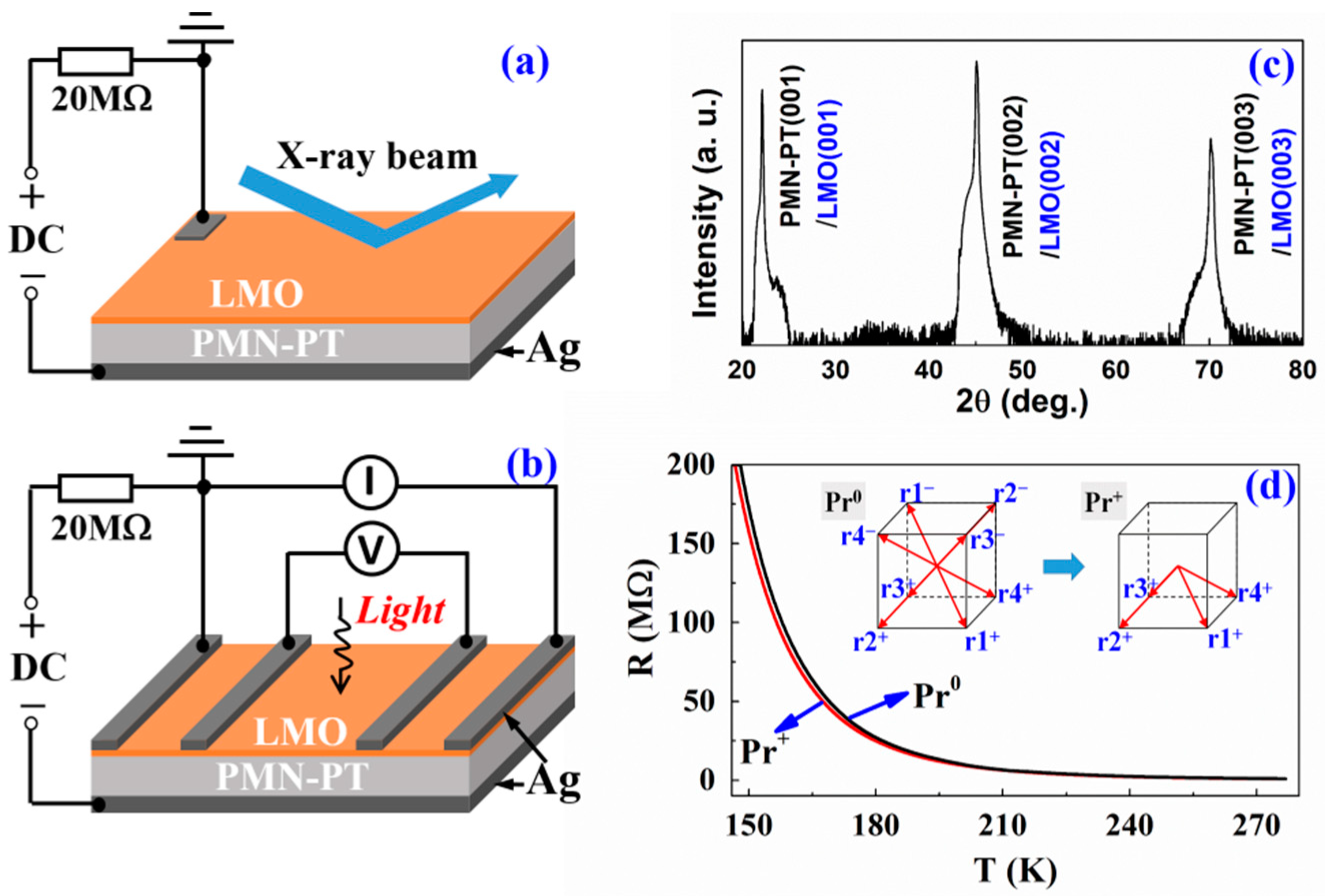
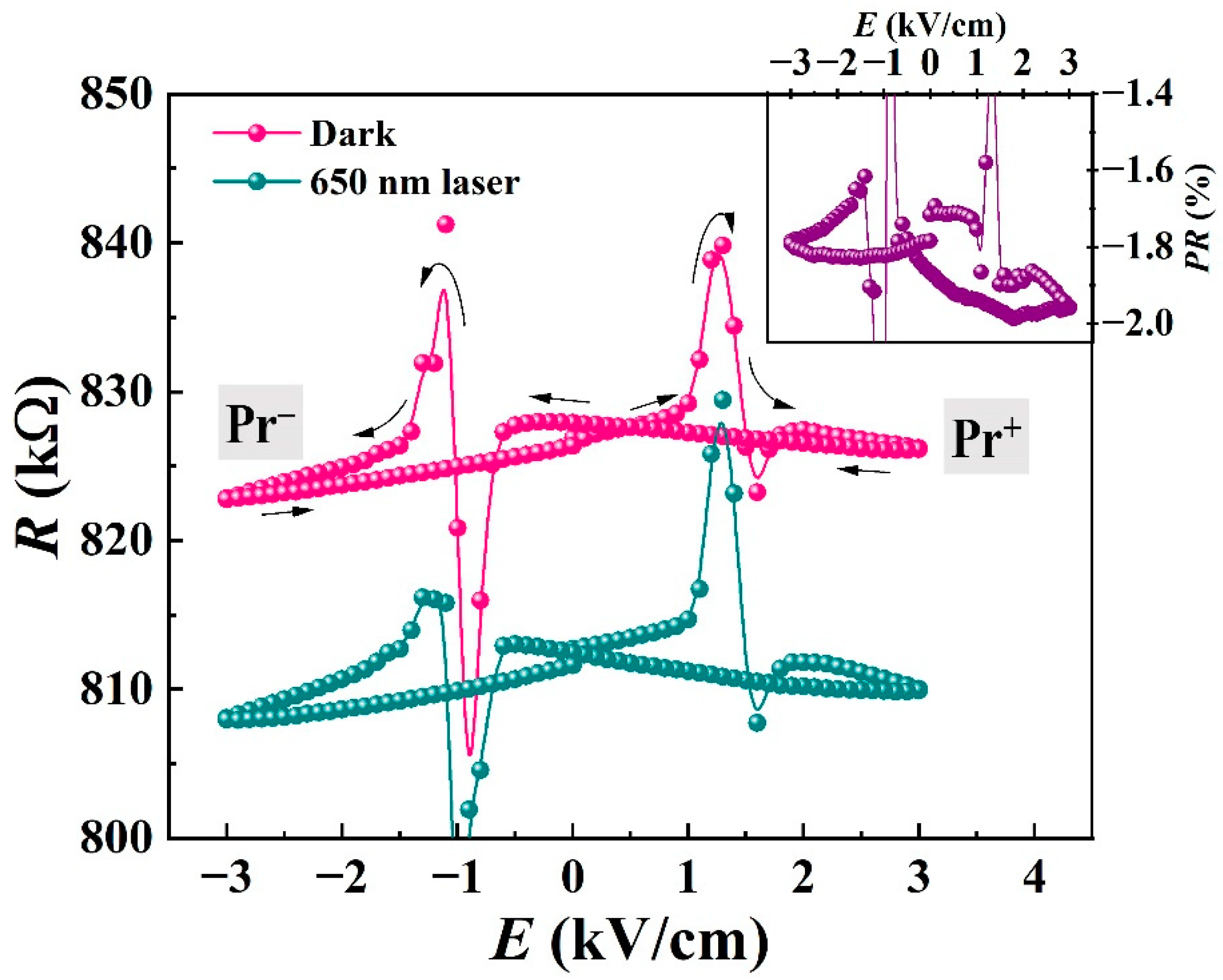
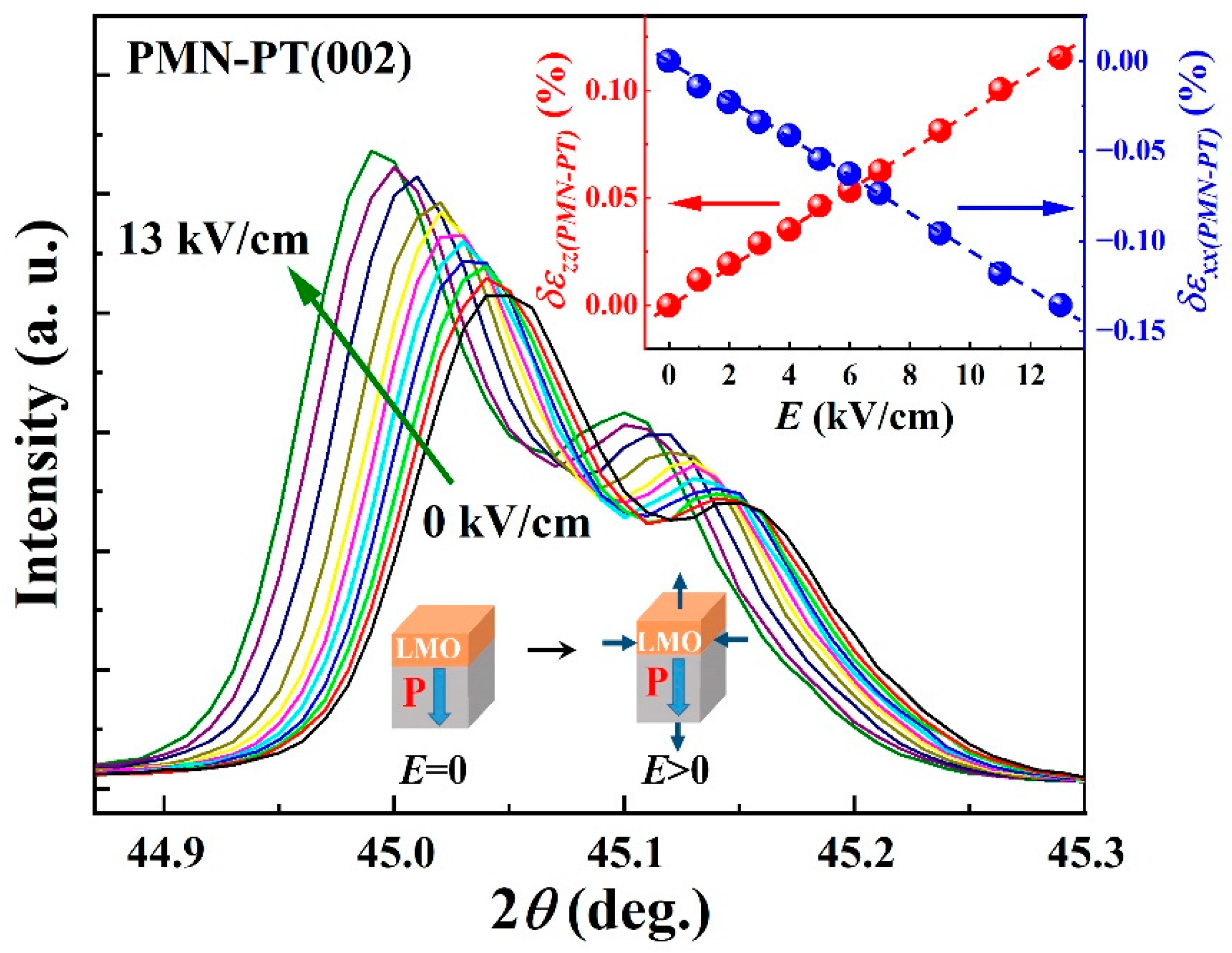
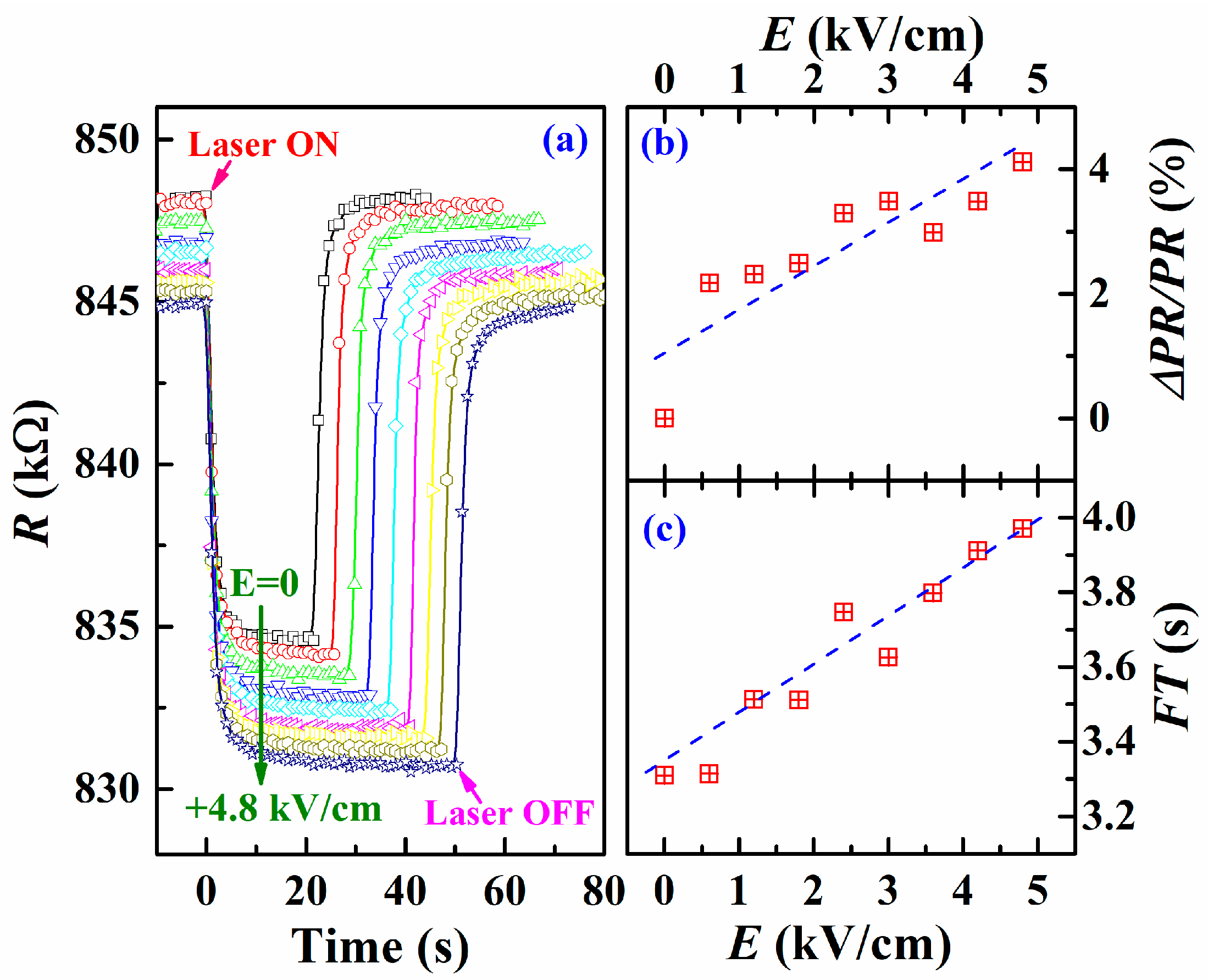
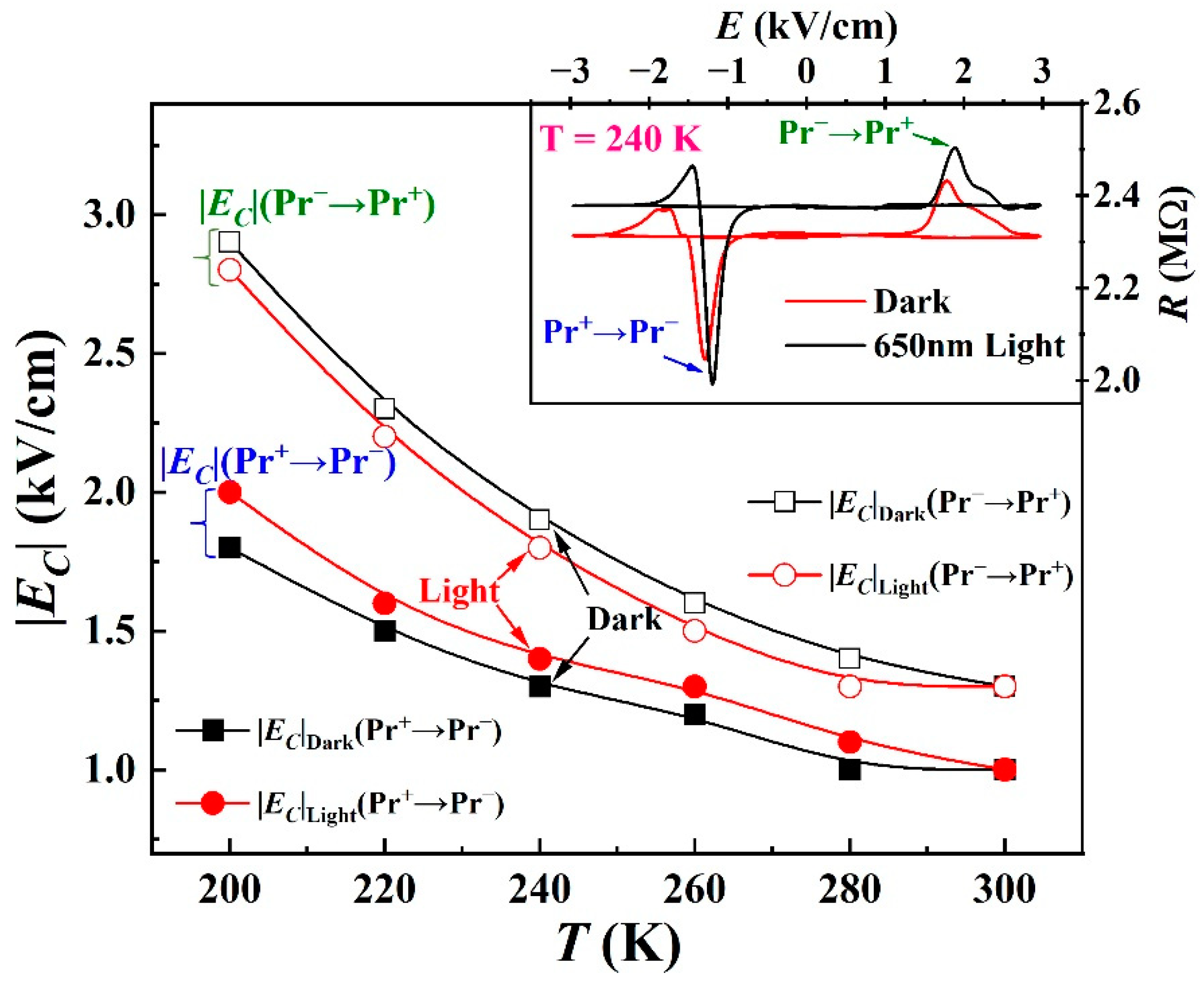
Publisher’s Note: MDPI stays neutral with regard to jurisdictional claims in published maps and institutional affiliations. |
© 2022 by the authors. Licensee MDPI, Basel, Switzerland. This article is an open access article distributed under the terms and conditions of the Creative Commons Attribution (CC BY) license (https://creativecommons.org/licenses/by/4.0/).
Share and Cite
Ni, H.; Wang, Y.; Zhang, F.; Yang, J.; Wang, M.; Guo, X.; Chen, L.; Wang, S.; Zheng, M. Electric-Field-Tunable Transport and Photo-Resistance Properties in LaMnO3−x/PMN-PT Heterostructures. Coatings 2022, 12, 890. https://doi.org/10.3390/coatings12070890
Ni H, Wang Y, Zhang F, Yang J, Wang M, Guo X, Chen L, Wang S, Zheng M. Electric-Field-Tunable Transport and Photo-Resistance Properties in LaMnO3−x/PMN-PT Heterostructures. Coatings. 2022; 12(7):890. https://doi.org/10.3390/coatings12070890
Chicago/Turabian StyleNi, Hao, Yi Wang, Feng Zhang, Jinwei Yang, Meng Wang, Xin Guo, Lu Chen, Shengnan Wang, and Ming Zheng. 2022. "Electric-Field-Tunable Transport and Photo-Resistance Properties in LaMnO3−x/PMN-PT Heterostructures" Coatings 12, no. 7: 890. https://doi.org/10.3390/coatings12070890
APA StyleNi, H., Wang, Y., Zhang, F., Yang, J., Wang, M., Guo, X., Chen, L., Wang, S., & Zheng, M. (2022). Electric-Field-Tunable Transport and Photo-Resistance Properties in LaMnO3−x/PMN-PT Heterostructures. Coatings, 12(7), 890. https://doi.org/10.3390/coatings12070890






